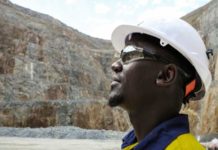
[miningmx.com] — THERE must have been good reason to divide Iscor Ltd into separate steel and mining businesses back in 2001. Ten years later, Iscor’s successor, ArcelorMittal SA (Amsa), is doing all it can to reassemble Iscor Mining by securing ownership of manganese, hard coking coal and, most recently, iron ore resources. I suppose that then, as now, broad economic factors are the driving force behind the strategy.
Hans Smith was the CEO of Iscor in 2001 when he finally relented and pursued the unbundling of Iscor’s mining assets into Kumba Resources, which later spawned a couple of lucrative empowerment deals. Smith’s hand was forced when tough trading conditions helped give Iscor’s new stainless steel plant, Saldanha Steel, a joint venture with the Industrial Development Corporation (IDC), the worst possible start.
Today, the vaulting cost of steel feed minerals is compelling the group to integrate vertically again. That’s why Amsa CEO Nonkululeko Nyembezi-Heita is desirous of finding additional iron ore resources to match the prospect she hopes will soon be awarded a permit in the Northern Cape. “We’re looking for a cluster of mines,’ says Nyembezi-Heita.
At full production tilt, Amsa could consume 10.5 million tonnes (mt) of iron ore. But in its last financial year, the company consumed about 7.5mt as it operated below nameplate capacity, especially in the flat carbon steel division which produced at only 67% of capacity. Of this iron ore consumption, some 2.5mt is supplied by Kumba Iron Ore’s Thabazimbi mine, which has a life stretching to 2016 assuming current mining rate and resources.
Says Nyembezi-Heita: “Once the market returns to normality, we’re going to need more iron ore. The company sources some material from Beeshoek, jointly managed by Assmang and African Rainbow Minerals, but Amsa is looking to source nearly half its iron ore from other self-owned operations.
“Let me know if you know of any mines,’ she says.
What Amsa appears to think is that it’s better to lay down the capital and operate the mine than compete in the contract and spot market for iron ore, coal and manganese. Majority shareholder ArcelorMittal is itself pursuing the strategy, tying up supply agreements for iron ore in places as diverse as Liberia and Canada.
It much prefers price certainty – the cost of building a mine or paying for an equity stake in a producer – to tackling northwards-heading commodity markets. Therefore, you can be sure Amsa’s main shareholder won’t mind it adding mining to steelmaking, although one wonders where the skills will come from. Contract mining, perhaps?
Amsa already owns 16% of Coal of Africa (CoAL), which is controversially hoping to dig for hard coking coal at its Vele mine as well as its newly acquired Makhado prospect. “We’re hoping John (Wallington, CEO of CoAL) can do a job for us. Iscor searched the length and breadth of South Africa looking for hard coking coal,’ says Nyembezi-Heita, somewhat doubtfully. She won’t say whether Amsa will at some point look at taking out CoAL, but if it can make good on Wallington’s claim that South Africa’s Limpopo province could produce 10mt of the stuff annually, Amsa may well do that.
Incidentally, Amsa also has a 50% stake in Kalagadi Manganese, the asset which is owned by Kalahari Manganese and which recently declared itself prepared to rail ore down to Coega where it will smelt a beneficiated product. The steelmaker is doubtless looking for more chances to take out its reliance on producers such as Kumba Iron Ore, with whom it is unlikely ever to have a normal business relationship again.
Of Amsa’s iron ore prospect, little is known. Capital required for the project will be from existing resources; infrastructure (rail, what else?) can be provided through the Sishen rail. All Nyembezi-Heita will say is that there are no skeletons in the cupboard in terms of its owner. “It’s a private company. We agreed not to say anything at this stage,’ she says.











